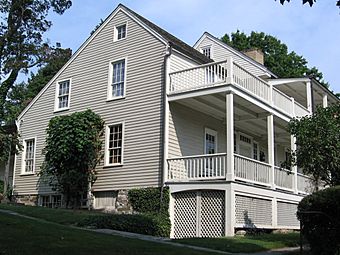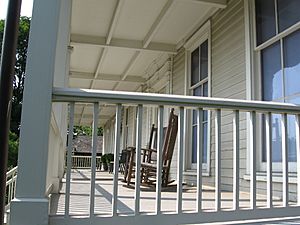Bush–Holley House facts for kids
|
Bush–Holley House
|
|
|
U.S. Historic district
Contributing property |
|

The Bush–Holley House
|
|
| Location | 39 Strickland Rd., Greenwich, Connecticut |
|---|---|
| Built | 1732 |
| Architectural style | Colonial |
| Part of | Strickland Road Historic District (ID77001625) |
| NRHP reference No. | 88002694 |
Quick facts for kids Significant dates |
|
| Added to NRHP | December 1, 1988 |
| Designated NHL | July 17, 1991 |
| Designated CP | March 22, 1990 |
The Bush–Holley House is a very old and important house in Greenwich, Connecticut. It's located in the Cos Cob area. This house is special because it's a National Historic Landmark, which means it's recognized as a place important to the history of the United States. Today, it's a historic house museum where you can learn about its past.
The house was built around 1730. Later, in the late 1800s, it became a boarding house. This means people could rent rooms there. It was also the heart of the Cos Cob Art Colony, which was Connecticut's first art colony. From 1890 to 1920, many famous artists, writers, and editors gathered here. Art students also came to learn from well-known American Impressionist painters. These artists included John Henry Twachtman, J. Alden Weir, Theodore Robinson, and Childe Hassam.
Today, the Historical Society of the Town of Greenwich takes care of the Bush–Holley House. You can visit it and take tours to explore its history.
Contents
A Look Back: The Bush and Holley Families
The Bush Family's Story
The Bush–Holley House was built in different steps. It started between 1728 and 1730 as a small, two-story building. It sat on a hill with a view of the harbor. The main "salt box" style house was finished a few years later.
In 1738, a Dutch farmer named Justus Bush bought the house. His son, David Bush, inherited it. From 1755 to 1777, David made many changes. He connected the two buildings to create an entrance hall. He also added wood panels to the main rooms and attached another building to make a "back kitchen."
In 1777, David Bush married Sarah Scudder Isaacs. She had five children, and David had five of his own. They then had five more children together! David Bush also had ten enslaved people living in his home. This made him the largest slave owner in Greenwich at that time. After David died in 1797, his son, Justus Luke Bush, took over the house.
The Holley and MacRae Families
The Bush family sold the house in 1848. Josephine and Edward Holley bought it. The Holleys added new windows and a second-story porch. In 1882, they started using the house as a place for artists and writers to stay.
In the summer of 1896, an artist named Elmer Livingston MacRae came to Cos Cob. He was there to take an outdoor painting class. While staying at the house, he met and fell in love with Emma Constant Holley. She was Josephine and Edward's daughter.
MacRae moved into the house for good in 1899. He married Emma on October 17, 1900. They had twin girls, Constant and Clarissa, on October 31, 1904. Elmer MacRae later became the leader of the Cos Cob Art Colony. For twenty years, Elmer and Emma continued to run the boarding house. It also served as a studio and a place to show MacRae's artwork.
Bush–Holley House Today
The Historical Society of the Town of Greenwich bought the house in 1957. They bought it from Constant Holley MacRae, who was Emma's daughter and Elmer's widow. The house first opened as a museum in 1958.
The main house was added to the National Register of Historic Places in 1988. This list recognizes places important to American history. It was then named a National Historic Landmark in 1991.
When you visit the Bush–Holley House, you can take guided tours. These tours show you the historic rooms. You can see how the Bush and Holley families lived. The house also has a collection of American Impressionist art. The William Hegarty Gallery at the site features special exhibitions. These shows focus on the art and artists of the Cos Cob art colony. They also highlight museum collections and different parts of Greenwich's history.
See also




